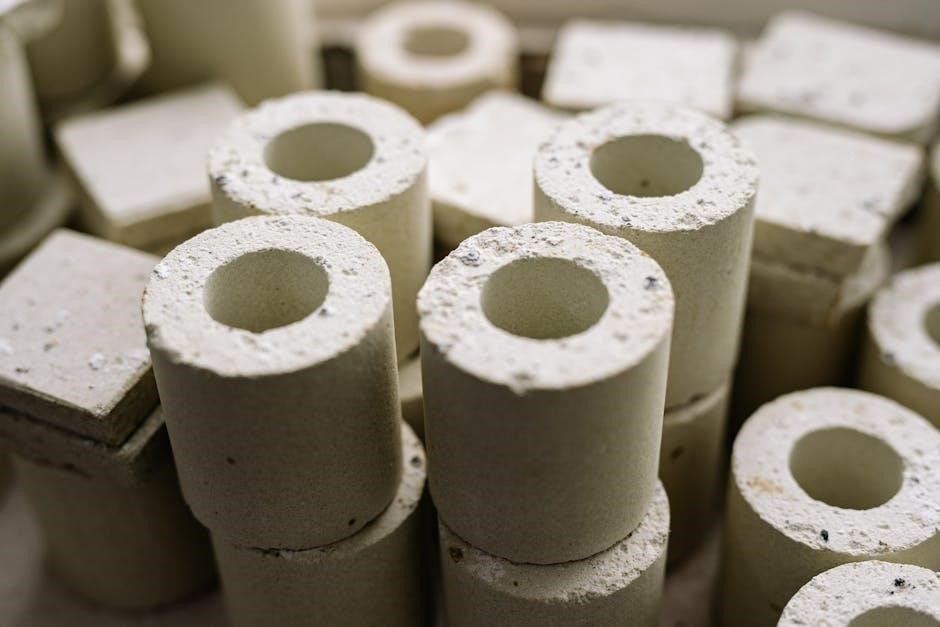A standardized glossary is crucial for clear communication within the composite materials industry. It ensures everyone understands terms‚ reducing ambiguity in design‚ manufacturing‚ and research endeavors‚ ultimately improving efficiency.
The glossary aims to define common and specialized terms related to composite materials. It encompasses manufacturing processes‚ material properties‚ defect terminology‚ and advanced concepts‚ providing a comprehensive resource for professionals and students alike.
The composite materials industry‚ encompassing diverse fields from aerospace to civil engineering‚ necessitates a standardized glossary. Ambiguity in terminology can lead to misinterpretations‚ design flaws‚ and manufacturing errors. A well-defined glossary ensures clear communication among engineers‚ researchers‚ and manufacturers‚ fostering collaboration and innovation. Standardized definitions minimize confusion when discussing material properties‚ manufacturing techniques‚ and defect analysis. This clarity is especially vital in international collaborations‚ where language barriers can exacerbate terminological discrepancies.
Furthermore‚ a consistent glossary supports accurate documentation and regulatory compliance. Precise definitions facilitate the creation of technical specifications‚ safety standards‚ and quality control procedures. This consistency is crucial for maintaining product reliability and safety across different applications. By establishing a common language‚ a standardized glossary promotes efficiency‚ reduces errors‚ and enhances the overall quality of composite material related activities.
Importance of a Standardized Glossary
Scope and Purpose of a Composite Terms Glossary

This composite terms glossary aims to provide a comprehensive and accessible resource for defining key concepts within the field. Its scope encompasses various aspects of composite materials‚ including constituent materials‚ manufacturing processes‚ material properties‚ testing methodologies‚ and defect analysis. The glossary is designed to serve a broad audience‚ including students‚ engineers‚ researchers‚ and industry professionals involved in the design‚ manufacturing‚ and application of composite materials.
The primary purpose is to promote consistent understanding and communication across different disciplines and sectors. By providing clear and concise definitions‚ the glossary aims to reduce ambiguity and facilitate effective knowledge sharing. Furthermore‚ it serves as a valuable tool for education and training‚ enabling individuals to quickly grasp essential concepts and terminology. The glossary also supports standardization efforts by providing a foundation for developing industry-wide standards and best practices in the composite materials field.

Key Concepts in Composite Materials
Composite materials are engineered materials made from two or more constituent materials with significantly different physical or chemical properties. These materials‚ when combined‚ produce a material with characteristics different from the individual components.
Definition of Composite Material
A composite material is engineered by combining two or more constituent materials with distinct physical or chemical properties. These constituents remain separate and distinct at the macroscopic level within the finished structure. The aim is to create a new material with superior properties compared to the individual components. Composites often consist of a matrix and a reinforcement. The matrix binds the reinforcement together and distributes the load. Common matrix materials include polymers‚ metals‚ and ceramics. Reinforcements provide strength and stiffness and can be in the form of fibers‚ particles‚ or flakes. The combination results in enhanced strength‚ stiffness‚ weight reduction‚ corrosion resistance‚ or thermal properties tailored for specific applications.
Constituent Materials: Matrix and Reinforcement
Composite materials are fundamentally composed of two key constituents: the matrix and the reinforcement. The matrix serves as the continuous phase‚ binding the reinforcement together and transferring stress between them. Common matrix materials include polymers (thermosets and thermoplastics)‚ metals‚ and ceramics‚ each offering unique properties. The reinforcement‚ the discontinuous phase‚ enhances the mechanical properties of the composite. Fibers‚ particles‚ and flakes are typical forms of reinforcement. Fibers‚ such as glass‚ carbon‚ and aramid‚ provide high strength and stiffness. Particles and flakes improve properties like wear resistance or thermal conductivity. The careful selection and combination of matrix and reinforcement determine the overall performance characteristics of the composite material‚ enabling tailored solutions for diverse engineering applications.
Types of Reinforcements (Fibers‚ Particles‚ etc.)
Reinforcements in composite materials come in various forms‚ each contributing distinct properties to the final composite. Fibers are a prevalent type‚ offering high tensile strength and stiffness. Common fiber materials include glass‚ carbon‚ aramid (Kevlar)‚ and natural fibers like flax or hemp. Particles‚ another type of reinforcement‚ enhance properties such as wear resistance‚ hardness‚ and thermal conductivity. Examples include silica‚ alumina‚ and carbon black. Whiskers‚ single-crystal fibers‚ provide exceptional strength and stiffness but are more expensive. Flakes‚ like mica or aluminum flakes‚ improve barrier properties and dimensional stability. The choice of reinforcement depends on the desired properties and application of the composite material. Different orientations and arrangements of reinforcements also impact the composite’s overall performance.

Common Terms Related to Manufacturing Processes
Composite manufacturing involves distinct processes like lay-up‚ curing‚ and molding. Understanding the terminology associated with these techniques is crucial for effective production and quality control in composite fabrication.
Lay-up Processes (Hand Lay-up‚ Automated Fiber Placement)
Lay-up processes involve placing reinforcement materials‚ such as fibers or fabrics‚ onto a mold to create the desired composite shape. Hand lay-up is a manual process where operators position the reinforcement and apply resin. It’s suitable for small production runs and complex geometries. Automated Fiber Placement (AFP) uses robotic systems to accurately place continuous fiber tows onto the mold surface‚ offering higher precision and faster production speeds. AFP is ideal for large‚ complex parts with demanding performance requirements. The choice between hand lay-up and AFP depends on factors like production volume‚ part complexity‚ and required precision. Both methods are fundamental in composite manufacturing‚ contributing to the creation of diverse composite structures.

Curing Processes (Autoclave‚ Oven Curing)
Curing processes are essential for solidifying the resin matrix in composite materials‚ transforming them from a liquid to a solid state. Autoclave curing involves placing the composite part in a pressurized oven‚ applying heat and pressure simultaneously. This method ensures uniform consolidation and minimizes void content‚ resulting in high-quality parts. Oven curing‚ on the other hand‚ utilizes only heat to cure the resin‚ often at atmospheric pressure. It’s a simpler and more cost-effective method suitable for less demanding applications. The choice between autoclave and oven curing depends on factors like part size‚ complexity‚ required mechanical properties‚ and budget constraints. Proper curing is critical for achieving optimal performance and durability in composite structures‚ ensuring their long-term reliability in service.
Molding Techniques (Resin Transfer Molding‚ Compression Molding)

Molding techniques play a crucial role in shaping composite materials into desired forms. Resin Transfer Molding (RTM) involves injecting resin into a closed mold containing reinforcing fibers. This process allows for the creation of complex shapes with good surface finish and consistent quality. Compression molding‚ conversely‚ involves placing a prepreg or a mixture of resin and fibers into a mold cavity and then applying heat and pressure to consolidate the material. This technique is well-suited for high-volume production of relatively simple parts. Both RTM and compression molding offer distinct advantages depending on the specific application‚ including factors like part complexity‚ production volume‚ material costs‚ and desired mechanical properties. Selecting the appropriate molding technique is vital for optimizing the manufacturing process and ensuring the final product meets performance requirements.

Material Properties and Testing Terminology
Understanding material properties and testing terminology is essential for evaluating composite performance. This section defines key terms related to mechanical‚ thermal‚ and other relevant characteristics‚ along with common testing methods used.
Mechanical Properties (Tensile Strength‚ Flexural Strength)
Mechanical properties are crucial in composite material selection and performance evaluation. Tensile strength quantifies a material’s resistance to breaking under tension or pulling force. It is a critical parameter for applications where the composite is subjected to stretching loads. Flexural strength‚ also known as bending strength‚ measures a material’s ability to resist deformation under bending loads. This property is particularly important in applications where the composite will be subjected to bending forces‚ such as in structural components. Both tensile and flexural strength are influenced by factors like the type of reinforcement‚ matrix material‚ and the fiber-matrix interface. Understanding these properties is vital for ensuring structural integrity.
Thermal Properties (Glass Transition Temperature‚ Thermal Expansion)
Thermal properties dictate a composite’s behavior under varying temperatures. The glass transition temperature (Tg) is a critical parameter for polymers within composites. It marks the temperature at which the polymer transitions from a rigid‚ glassy state to a more flexible‚ rubbery state. Exceeding Tg can significantly affect the composite’s mechanical performance and structural integrity. Thermal expansion refers to how much a material expands or contracts with changes in temperature. The coefficient of thermal expansion (CTE) is crucial in composite design‚ especially when combining different materials. Mismatched CTEs can lead to internal stresses‚ potentially causing delamination or failure under thermal cycling. Considering these thermal properties is essential for ensuring long-term reliability.
Testing Methods (Non-Destructive Testing‚ Destructive Testing)
Evaluating composite material integrity involves diverse testing methods. Non-destructive testing (NDT) techniques‚ like ultrasonic testing and radiography‚ identify internal flaws without damaging the composite. These methods are crucial for quality control during manufacturing and in-service inspections. Destructive testing‚ on the other hand‚ involves subjecting the composite to increasing loads until failure to determine its strength and stiffness. Tensile tests‚ flexural tests‚ and impact tests are common examples of destructive methods. Data from destructive tests provide valuable insights into material behavior and validate design assumptions. Combining both NDT and destructive testing provides a comprehensive assessment of composite performance‚ ensuring structural reliability and safety in various applications by spotting any imperfections or weakness that might exist.

Defect Terminology in Composites
Understanding defect terminology is crucial for assessing composite material quality. This section defines common defects‚ their causes‚ and methods for inspection and repair‚ ensuring structural integrity and performance.
Types of Defects (Voids‚ Delaminations‚ Cracks)
Several types of defects can compromise the structural integrity of composite materials. Voids‚ which are pockets of entrapped gas‚ can weaken the matrix and reduce overall strength. Delaminations‚ or separations between layers of the composite‚ significantly diminish interlaminar shear strength. Cracks‚ both micro and macro‚ can propagate under stress‚ leading to catastrophic failure. These defects are often introduced during manufacturing processes like curing or lay-up. Other examples include fiber misalignments affecting directional strength and resin-rich or resin-starved areas impacting uniformity. Properly identifying these defects through visual inspection or advanced non-destructive testing methods such as ultrasonic or radiographic techniques is essential for quality control. Understanding the characteristics of each defect type allows for targeted repair strategies and improved composite performance.
Causes of Defects
Defects in composite materials arise from various factors throughout the manufacturing process. Improper handling of materials‚ such as contamination or incorrect storage‚ can lead to voids and weak bonding. Inadequate control during lay-up‚ including incorrect fiber orientation or insufficient resin impregnation‚ contributes to inconsistencies. Issues during curing‚ like uneven temperature distribution or insufficient pressure‚ can cause delaminations and residual stresses; Furthermore‚ machining processes‚ if not carefully executed‚ may introduce cracks and edge effects. Environmental factors‚ such as humidity and temperature fluctuations‚ can also play a role. The presence of foreign particles‚ such as dust or release agents‚ can act as stress concentrators. Understanding these root causes is crucial for implementing effective preventative measures and optimizing composite manufacturing techniques. Thorough process control and quality assurance are vital for minimizing defects and maximizing the performance of composite structures.
Inspection and Repair Techniques
Effective inspection and repair techniques are critical for ensuring the structural integrity of composite components. Non-destructive testing (NDT) methods‚ such as ultrasonic testing‚ radiography‚ and thermography‚ are employed to detect internal defects without damaging the material. Visual inspection is also crucial‚ looking for surface cracks and delaminations. When defects are identified‚ appropriate repair strategies must be implemented. For minor surface damage‚ patching with resin and reinforcement materials is common. More significant damage may require scarf repairs‚ where the damaged area is carefully removed and replaced with a new composite section‚ ensuring a smooth transition. Bonded repairs‚ involving adhesives‚ are also used. The selection of repair technique depends on the size‚ location‚ and nature of the defect‚ as well as the application and performance requirements of the composite structure. Proper surface preparation‚ material selection‚ and curing procedures are essential for a successful repair‚ restoring the composite’s strength and durability. Regular inspection and timely repairs prolong the lifespan of composite structures.

Advanced Composite Terminology
Nanocomposites incorporate nanoscale fillers into a matrix material‚ enhancing properties like strength and conductivity. These materials offer improved performance compared to traditional composites due to the high surface area of nanofillers.

Nanocomposites
Nanocomposites are a class of composite materials where at least one constituent material has dimensions in the nanometer range (1-100 nm). Typically‚ these consist of a matrix material reinforced with nanoparticles‚ nanofibers‚ or nanoplates. The incorporation of nanoscale reinforcements can significantly enhance the mechanical‚ thermal‚ electrical‚ and barrier properties of the composite compared to conventional composites.
Key advantages of nanocomposites include improved strength‚ stiffness‚ toughness‚ and dimensional stability. They also offer enhanced resistance to chemicals‚ heat‚ and ultraviolet radiation. Common nanoparticle reinforcements include carbon nanotubes‚ graphene‚ nanoclays‚ and metal oxides. The effectiveness of the reinforcement depends on factors such as the size‚ shape‚ dispersion‚ and alignment of the nanoparticles within the matrix.
Applications of nanocomposites span various industries‚ including aerospace‚ automotive‚ electronics‚ and biomedical engineering. They are used in lightweight structural components‚ high-performance coatings‚ sensors‚ and drug delivery systems.
Smart Composites
Smart composites‚ also known as intelligent composites‚ are advanced materials engineered to sense and respond to environmental stimuli or applied loads. These materials integrate sensors‚ actuators‚ and control systems within a composite structure‚ enabling them to monitor their condition and adapt their behavior accordingly. The integration of these functionalities leads to enhanced performance‚ improved safety‚ and extended service life.
Common types of sensors used in smart composites include fiber optic sensors‚ piezoelectric sensors‚ and strain gauges. These sensors can detect changes in strain‚ temperature‚ pressure‚ or other parameters. Actuators‚ such as shape memory alloys or piezoelectric materials‚ are used to induce changes in the composite’s shape‚ stiffness‚ or damping characteristics.
Applications of smart composites include aerospace structures‚ civil infrastructure‚ and biomedical devices. They are used in aircraft wings‚ bridges‚ and implants to provide real-time monitoring‚ damage detection‚ and adaptive control capabilities. Smart composites offer the potential to create self-healing structures and optimize performance in dynamic environments.
Bio-Composites
Bio-composites are composite materials made from natural or renewable resources. They typically consist of a matrix derived from bio-based polymers and reinforcements made from natural fibers‚ such as flax‚ hemp‚ or jute. The use of bio-based materials reduces reliance on fossil fuels and promotes sustainable manufacturing practices. These materials are gaining popularity due to their biodegradability‚ low density‚ and potential for carbon sequestration.
The matrix in bio-composites can be derived from sources like starch‚ cellulose‚ or vegetable oils. Natural fibers provide reinforcement and enhance the mechanical properties of the composite. However‚ bio-composites often exhibit lower strength and moisture resistance compared to traditional composites. Research efforts are focused on improving their performance through chemical treatments‚ fiber modifications‚ and advanced processing techniques.
Applications of bio-composites include packaging‚ automotive components‚ and construction materials. They are used in interior parts of vehicles‚ panels‚ and insulation materials. The growing demand for eco-friendly materials is driving the development and adoption of bio-composites in various industries.
